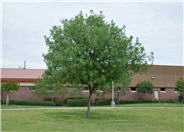
Common name:Chinese Pistache
Botanical name:Pistacia chinensis
The Pistacia chinensis is a deciduous tree with broad, spreading growth to 50' in height. Its leaves have 10-16 leaflets, and the fall coloring arrives in beautiful shades of red, orange and yellow. Prune young trees to shape. This tree does not have edible nuts. Female trees have tiny red fruit, turning dark blue. It prefers full sun and deep, infrequent waterings. This is a great street or park tree.
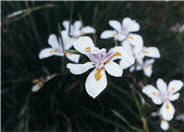
Common name:Butterfly Iris or Fortnight Lily
Botanical name:Dietes iridioides
This clumping evergreen iris bears tall, narrow leaves to 30" tall and white flowers marked purple in the center on stalks to 3' tall, appearing spring through fall. This variety has stiffer, darker foiliage than the bicolor form. It requires sun to part shade with little or no summer watering when established. This is a very reliable plant. Divide every 3-5 years to keep it looking fresh.
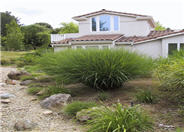
Common name:Karl Foerster Feather Reed Grass
Botanical name:Calamagrostis X acutiflora 'Karl Foerste
This ornamental perennial grass grows 4-6' tall x 1-1.5' wide and has semi-evergreen foliage that is green in spring and summer and turns green/brown in fall. The flowers bloom in mid June and emerge a light green but quickly turn to pink/purple.
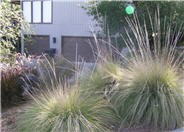
Common name:Deer Grass
Botanical name:Muhlenbergia rigens
The Deer Grass is a warm season perennial that forms dense clumps from the base. The spike-like flower stalks grow 2'-3' tall and this grass has striking foundation form. The Deer Grass is native to California and needs watering once or twice a month after it has been established. The more water it has, the greener it is.
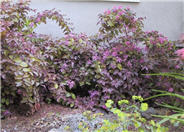
Common name:Red Fringe Flower cultivar
Botanical name:Loropetalum chinense v. rubrum
Red Fringe Flower is a shrub that grows 6'-12' tall and wide. It has arching branches with light green and reddish leaves. Pink flowers bloom intermittently throughout the year. This attractive shrub prefers afternoon shade and shelter from hot, drying winds. It needs a moderate amount of watering.
In the natural world the endless cycle of birth, growth, decay, death and rebirth flows throughout the seasons. Plants die, leaves fall and new growth springs up in its place. Nothing is lost and the fallen leaves and dead plants decay into the soil, enriching it for the next generation of growth.
Click in the green box for more information
Designer: Robery Boro, Jody Palmer
Photographer: GardenSoft
Incorporate compost 6" into your soil to retain water, reduce compaction, feed earthworms, and provide valuable nutrients to your plants.
Attract, or buy beneficial insects such as ladybugs and lacewings to control pest outbreaks in your garden.